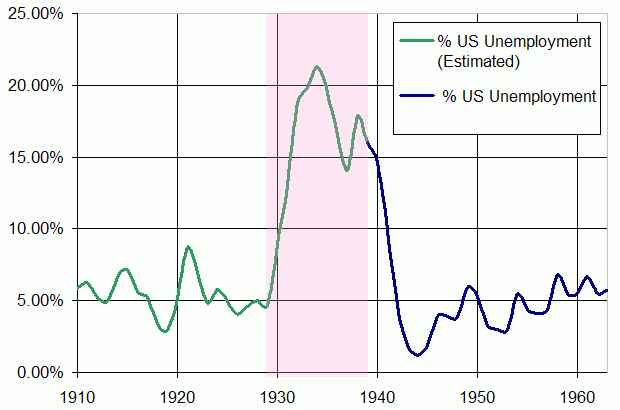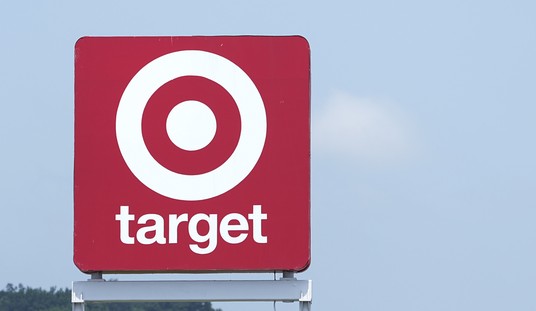There is a question that has been debated in some circles for a while now: Are the union-controlled Democrats purposely trying to drive the nation into another Great Depression, or are they just that ignorant?
The problem is, no matter how you answer that question (ignorance or malice), both are dangerous for the country. In the spirit of optimism in humanity, one probably could believe that it is ignorance (that, and a strange crush on John Maynard Keynes). However, given the Marxist March on Washington this past weekend, it’s really tough to think that there isn’t some nefarious scheme being passed around from Nancy Pelosi’s PDA to the President’s teleprompter. To further add to those nagging suspicions is the fact that all Democrats need to do is open a history book and watch how they’re making the same mistakes (intentional or not) that the political leaders of the 1930s made.

Repeating the Past. A decade of low employment and “irrational exuberance” was followed by a tanking of the stock market. Then, a well-spoken president comes in (no teleprompters in those days), greatly expanding government power, spending wildly, enacting new entitlements, demonizing business, levying heavy taxes, as well as cozying up to union bosses. And, despite all of those government-spending programs, unemployment remains extraordinarily high.
Does this sound eerily familiar? Indeed it should, because 70 years later Democrats are making many of the same mistakes that were made during the Great Depression—and it may be about to get a whole lot worse.
Are Democrats About to Make High Unemployment Higher?
We’ve opined in the past about how businesses are averse to risk. Now, even the New York Post, in an oped by Sen. James Inhofe (R-OK), is labeling the Obama administration’s regulatory uncertainty Obama’s ‘quietest job-killing machine.’
One insidious force keeping unemployment high is regulatory uncertainty: Companies that could hire (or re-hire), don’t — because they’re worried about what new restrictions will be coming down from Washington.
Congress bears much of the blame — especially for the new “financial reform” law, which leaves so many details to be filled in later. But a major contributor to businesses’ worries is the Obama Environmental Protection Agency, which is issuing a daily barrage of rules and regulations threatening jobs in American industry.
The Politics of Protectionism. The real ghost from decades past that Democrats seem to be resurrecting is the Smoot-Hawley Tariffs. The Smoot-Hawley Tariffs (signed into law in 1930 by President Hoover) were based on the misguided belief that, if America restricted trade, it would somehow translate into more jobs.
In short, the Smoot-Hawley Tariffs failed. Miserably. Not only did they fail, the Smoot-Hawley Tariffs made a bad situation worse as employment went into a freefall, soup and bread lines formed, and a depression became the Great Depression.
It provoked a storm of foreign retaliatory measures and came to stand as a symbol of the “beggar-thy-neighbor” policies (policies designed to improve one’s own lot at the expense of that of others) of the 1930s. Such policies contributed to a drastic decline in international trade. For example, U.S. imports from Europe declined from a 1929 high of $1,334 million to just $390 million in 1932, while U.S. exports to Europe fell from $2,341 million in 1929 to $784 million in 1932. Overall, world trade declined by some 66% between 1929 and 1934. More generally, Smoot-Hawley did nothing to foster trust and cooperation among nations in either the political or economic realm during a perilous era in international relations.

Smoot-Hawley Redux. Ironically, the Smoot-Hawley Tarrifs were passed and signed into law by Republicans—and, now, it is the Democrats who are falling into the same ill-conceived trap. In fact, the Tariff Act of 1930 (Smoot-Hawley’s official name) is still on the books. Now, though union-backed Democrats are dusting off the rusty idea of protectionist tariffs and, at the heart of the new eco-union empire, is the United Steelworkers.
The Steelworkers, which is formally known as the United Steel, Paper and Forestry, Rubber, Manufacturing, Energy, Allied Industrial and Service Workers International Union, with around 700,000 members, is the largest manufacturing union in North America today. After decades of unions helping to open the door to foreign competition by devastating strikes like the 1959 Great Steel Strike, America’s manufacturing unions have watched their base erode and, as a result, have been faced with an either-or: Either merge with other dying unions or die. For those unions that sought to survive, the United Steelworkers became the ‘melting pot’ for dying unions to jump into.

Strange Bedfellows. In 2006, something strange happened. Planets shifted, oil mixed with water and, after years of fighting environmental regulations that all-too-often killed union jobs, the United Steelworkers joined the Sierra Club to form the Blue-Green Alliance. Since the BGA’s founding, more of the ‘usual suspects’ have jumped into the Blue-Green Alliance:
Launched in 2006 by the United Steelworkers and the Sierra Club, this unique labor-environmental collaboration has grown to include the Communications Workers of America (CWA), Natural Resources Defense Council (NRDC), Service Employees International Union (SEIU), National Wildlife Federation (NWF), Laborers’ International Union of North America (LIUNA), Union of Concerned Scientists (UCS), Utility Workers Union of America (UWUA), American Federation of Teachers (AFT), Amalgamated Transit Union (ATU), Sheet Metal Workers’ International Association and the United Auto Workers.
[Heh. If one didn’t know any better, one could assume the BGA is one of those ‘shadowy groups with harmless-sounding names’ the president often likes refers to.]
The BGA’s seemingly benign goals listed on its website are as follows:
- Pass comprehensive clean energy and climate change legislation that is based on two overriding principles – the best scientific advice on reduction targets and solutions that create and save millions of American jobs;
- Restore the rights of workers in the United States to organize and bargain collectively;
- Establish a 21st Century trade policy that promotes growth and prosperity across all sectors of global society, and embeds enforceable labor, environmental, and human rights standards in our trade agreements; and
- Create an informed 21st century policy on toxic chemicals that protects workers and communities from dangerous chemicals, enhances public health and promotes safer alternatives.
The Blue-Green Alliance is the organization that has been backing the White House’s push toward ‘green jobs’ that will, of course, be unionized. The effects of the Blue-Green Alliance are already being felt in “eco-friendly” (but unaffordable) alternatives for consumers:
People who are interested in choosing fencing that uses sustainable materials have options, but most of them will cost more than traditional vinyl or wood fencing.
Pricing has prevented green fencing from becoming a major part of the market for many area companies and major home improvement stores like Home Depot and Lowe’s, according to those in the field.
[snip]
Murphy said her company does offer composite wood fencing, which uses a combination of vinyl, sawdust and recycled wood. But she said she only gets a few customers a year asking for that product.
Composite fencing can cost twice as much as vinyl fencing, which can run up to $130 per panel. A wood fence is still the cheapest option at about $50 per panel, she said.
The costliness of the ‘eco-friendly’ green economy (not to mention the lack of credibility of people like Al Gore) is causing consumers to shun the ‘sustainable stuff’ campaign—especially in the middle of a deep recession—and continue buying goods that are less expensive…even if they’re made overseas.
This makes people like Leo Gerard, the president of the Steelworkers union mad. You see, after taking his union to the green side, he’s perturbed that his members are still losing jobs because consumers are choosing, just as steel consumers did after the 1959 steel strike, cheaper alternatives to the eco-union alliance. So, as a result, to try to help speed things up, Gerard and his comrades have fallen back on the age-old protection of the government.
In 2009, the Steelworkers (and other unions) convinced their Democrat puppets in Congress to insert “buy American” language into the $787 billion, which immediately sparked outrage with the U.S. neighbors to the North.
This week, the Canadians fired back. A number of Ontario towns, with a collective population of nearly 500,000, retaliated with measures effectively barring U.S. companies from their municipal contracts — the first shot in a larger campaign that could shut U.S. companies out of billions of dollars worth of Canadian projects.
In September 2009, the Steelworkers once again order the Obama administration to impose trade penalties on China’s tires. Once again, Obama complied, sparking a sharp rebuke from China:
Chen Deming, China’s minister of commerce, said the penalties would hurt relations with the U.S. A ministry statement said Obama had “compromised to the political pressure of the U.S. domestic trade protectionism.”
“The Chinese government will continue to uphold the legitimate interests of China’s domestic industry and has the right to take corresponding measures,” Deming said.
Later in September (2009), the Steelworkers and three of the paper companies that employ USW members joined forces to instruct the White House to take on Asia over paper prices:
A trade tiff over tires may escalate into a full-fledged trade war, with American unions taking on Asian exporters.
Three American paper companies, joined by the union that represents their workers, charged on Wednesday that unfair trade practices in China and Indonesia have cost thousands of Americans their jobs by driving down the cost of paper.
Now, as the Steelworkers and the handful of unionized companies have campaigned for increasing tariffs, they have gone a step further by dragging their environmentalist allies into the fight, creating what the Consumers Alliance for Global Prosperity calls Empires of Collusion.

It gets worse. Last week, the House of Representatives, before heading home to campaign for the mid-term elections, took the first step in what may become a full-fledged trade war with Asia by passing HR2378, otherwise known as the Currency Reform for Fair Trade Act.
While generally worded, it is largely aimed at trying to curb China’s alleged currency manipulation—something that has plagued the U.S. for at least two administrations—the “do good” desires of the union-fronted Democrats (with bi-partisan backing in the House) may result in an economic disaster if history repeats itself.
While the bill still has to clear the Senate, the Wall Street Journal noted on Monday:
The bill, if passed by the Senate and signed by the president, would mandate that the Department of Commerce take a foreign country’s currency interventions into account in determining whether its trading practices are unfair. In the case of China—the target at which this bill is aimed—Commerce would determine that the amount by which the yuan is allegedly undervalued. The number being thrown around now by supporters of the bill, such as the AFL-CIO and the United Auto Workers, is as much as 40%. The cost basis of Chinese-made goods exported to the U.S. would then be adjusted upward by that amount to determine whether they are being sold below cost, an unfair trade practice known as “dumping.” Not a single Chinese export good could survive such a test—virtually the entire volume of China’s exports to the U.S. suddenly would become subject to countervailing duties.
Surely China would retaliate. That makes the bill a nuclear threat of mutual assured economic destruction. If carried out, it would crush trade between China and the United States, which are huge export markets for each other.
Given the already-fragile economy in the U.S., this nation’s debt to China, as well as China’s relative economic stability, it seems that a union-backed trade war is not something that should be entered into with all eyes wide open as it could easily lead to a full-scale depression, at least here in the U.S. and, likely, elsewhere.
This then, begs the question asked at the beginning: Are the union-controlled Democrats purposely trying to drive the nation into another depression, or are they just that ignorant?
Insanity: doing the same thing over and over again and expecting different results.
—Albert Einstein
On November 2nd, take a step at stopping the insanity: Vote.
__________________
“I bring reason to your ears, and, in language as plain as ABC, hold up truth to your eyes.” Thomas Paine, December 23, 1776
Cross-posted on LaborUnionReport.com
For more news and views on today’s unions, go to LaborUnionReport.com.














Join the conversation as a VIP Member